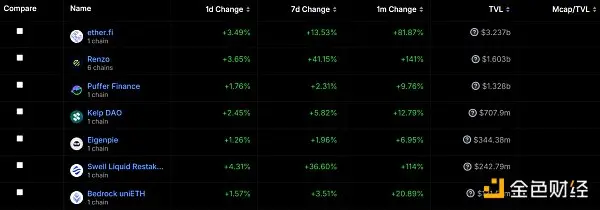The Refinement Journey of the Leading Re-staking Platform ether.fi
Written by: Climber, Golden Finance
On March 18, the Ethereum re-staking protocol ether.fi was launched on major exchanges. After a strong opening, it retreated to around $3, and then continued to rise, reaching a peak of $8.66 in less than two weeks. Such a significant short-term increase for a new project is rare, and with the re-staking sector gaining momentum, ether.fi, as the leader, is naturally worth attention.
This article will provide a comprehensive analysis of the leading project in this sector, ether.fi, helping readers understand the project while also aiming to identify its inherent value.
Strong Performance
From the price trend, ether.fi has performed remarkably since its launch. As of the time of writing, the lowest price of ETHFI was $2.83, and the highest was $8.66, with an increase of 208% during this period. For a newly listed token, a doubling in a short time is already quite significant.

From the project's on-chain data perspective, according to DefiLama, ether.fi's TVL currently stands at $3.252 billion. As shown in the chart, ether.fi's TVL entered a high growth mode around January this year, increasing from about $100 million to over $3 billion in just three months, a growth rate of 30 times.

Comparing with other competitors in the same sector, it is evident that ether.fi is far ahead of its peers, with a TVL approximately double that of the second-place Renzo. In terms of TVL growth, ether.fi, Renzo, and Swell Network all have monthly increases around 100%, with Renzo leading the pack.
Regarding the general high growth of TVL in the re-staking sector, a senior industry analyst stated that this is mainly due to the significant demand for projects that can provide consensus security through AVS services. At the same time, the re-staking sector is also favored by many institutions and investors.
Golden Finance detailed the development status of several leading projects in an article titled "Re-staking Sector Continues to Heat Up" published in early February this year, pointing out the potential for an explosion in the re-staking sector influenced by the Ethereum Cancun upgrade. Readers can refer to that article for more information.
Introduction to ether.fi
ether.fi is a non-custodial staking protocol built on Ethereum, founded by Mike Silagadze and launched in 2023.
Unlike other liquid staking protocols, ether.fi allows participants to retain control of their keys while staking tokens and enables them to exit validators at any time to reclaim their ETH.
This is primarily reflected in two aspects:
- Stakers generate and hold their own staking ETH keys.
- NFTs are minted for each validator launched through ether.fi.
For most other delegated staking protocols, the starting point is for stakers to deposit their ETH and match with node operators, who generate and hold staking receipts. Although this method can make the protocol non-custodial, it often creates a custodial or semi-custodial mechanism in most cases. This can expose stakers to significant and opaque counterparty risks.
Through ether.fi, stakers can control their keys and retain custody of their ETH while delegating staking to node operators, significantly reducing their risk exposure.
Technically, in Ethereum's PoS staking, two keys are generated: the withdrawal key and the validation key. The withdrawal key is used to withdraw users' assets, while the validation key is what node operators need to use within a specified time to validate blocks and earn validation rewards.
ether.fi achieves the separation of withdrawal keys and validation keys in staking delegation through key management technology, further optimizing the security of ETH staking services. It also creates a node service market where stakers and node operators can register nodes to provide infrastructure services, with the revenue from these services shared among stakeholders and node operators.
Users can earn investment returns by depositing funds into ether.fi and receiving staking rewards (supply-side fees). In this process, ether.fi can also automatically re-stake users' deposits with Eigenlayer to generate yields. Eigenlayer utilizes staked ETH to support external systems (such as rollups and oracles), enhancing the returns for ETH stakers by establishing an economic security layer.
The total of all staking rewards is distributed among stakers, node operators, and the protocol, with allocations of 90%, 5%, and 5%, respectively. Users can generally receive: Ethereum staking rewards; ether.fi loyalty points; re-staking rewards (including EigenLayer points); and rewards for providing liquidity to DeFi protocols.
Financing Information:
- ether.fi completed a $5.3 million financing round on February 2, 2023, led by North Island Ventures, Chapter One, and Node Capital, with participation from BitMex founder Arthur Hayes.
- Additionally, ether.fi completed a $23 million financing round in February this year, supported by over 95 investment institutions and individual investors, including Amber Group, BanklessVC, and OKX Ventures.
Currently, ether.fi has disclosed information about five team members in its official Docs, including founder Mike Silagadze, who is also the CEO of DeFi fund company Gadze Finance and the founder of the Canadian higher education platform Top Hat (which raised $130 million in Series E funding in 2021).
Token Economics:

The ether.fi token economic model shows that the total supply of the ether.fi token ETHFI is 1 billion, with an initial circulating supply of 115.2 million. In the token distribution, 2% is allocated for Binance Launchpool, 11% for airdrops, 32.5% for airdrop investors and advisors, 23.26% for the team, 1% for Protocol Guild, 27.24% for DAO Treasury, and 3% for providing liquidity.

However, regarding the unlocking timeline, ETHFI will not see a significant release until next year, and it will not exceed 60% until 2026, reflecting a certain scarcity of ETHFI in the market.
From the airdrop information on March 18, ether.fi's top 20 addresses contributed one-third of the TVL (273,000 ETH) and received 9.96 million ETHFI airdrop.
The largest airdrop recipient was Justin Sun, who deposited 120,000 ETH ($435 million) into ether.fi on the 13th, receiving 3.45 million ETHFI airdrop. The staking airdrop ratio was about 1:3, meaning users needed to stake 1 ETF to receive 3 ETHFI, which, at the highest ETHFI price, would amount to only $26.
Project Progress and Roadmap
In March this year, ether.fi launched the second season of the StakeRank points activity, running from March 15 to June 30, with rewards accounting for 5% of the total ETHFI supply. Recently, ether.fi conducted an airdrop of 68 million ETHFI (6.8% of the total) and initiated the Restaking Paradigm product in collaboration with Manta Network.
In February, the DeFi yield market Pendle announced a partnership with the Ethereum staking protocol ether.fi to launch the first LRT asset eETH on Arbitrum. In January, ether.fi announced the establishment of an advisory committee, with members including independent Ethereum educator sassal.eth, Polygon founder Sandeep Nailwal, Arrington Capital founder Michael Arrington, and Ethereum Foundation member SnapCrackle.eth.
In November last year, ether.fi launched its mainnet and released the liquid staking token eETH. In October, ether.fi introduced the liquid staking token (LST) eETH and announced its decentralized roadmap. In May, ether.fi launched the first phase of its mainnet.
According to its official roadmap:
- In August last year, ether.fi, in collaboration with Obol Labs, launched the first DVT mainnet validator, which was then included among the first batch of validators on the mainnet, operated by a geographically distributed group of small independent operators.
- In October last year, ether.fi open-sourced its smart contract suite. In November, it launched eETH, which is ether.fi's Liquid Stake token, allowing users to participate in Ethereum staking in a completely permissionless manner and buy and sell staking assets on demand.
- In April this year, ether.fi is expected to complete the second phase of DVT integration. In the first phase of DVT, ether.fi collaborated with Obol Labs to provide mainnet DVT—validation shared by different individuals, with no one holding the complete validator key. The second phase will shift to fully automated integration, allowing users to arrive, apply, and start as individual stakers without management and assistance from ether.fi and Obol.
At the same time, ether.fi will also implement DAO governance and TGE.
Additionally, ether.fi mainnet v3 is planned for release in early Q2, which will include some special features, such as allowing users to run personal nodes using a 2 ETH Bond.
Conclusion
Since last year, discussions and research around the re-staking sector have been increasing. At the beginning of this year, the re-staking sector showed signs of a comprehensive explosion, and ether.fi, as the leader in the sector, was the first to be listed on exchanges and performed excellently, making investors more optimistic about this sector.
For users who favor earning through staking, security and yield are the primary considerations. The DVT technology of ether.fi can significantly ensure the security of users' staking assets and also provide decent yields. Therefore, based solely on the current products and services of ether.fi, it indeed has certain prospects, although aspects related to smart contracts and technical security still require time to be tested.









